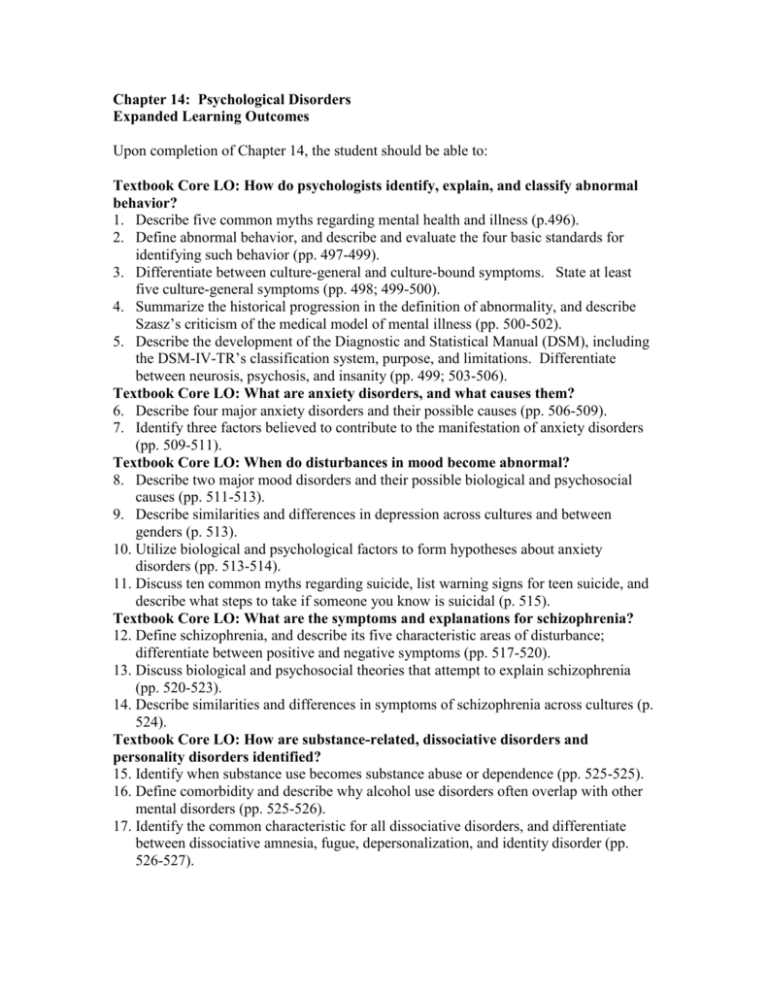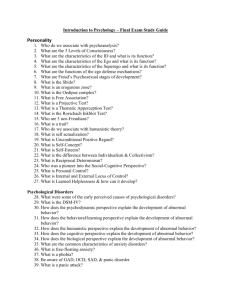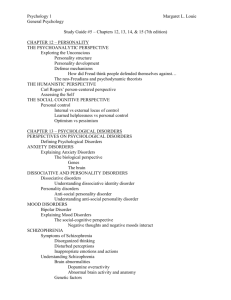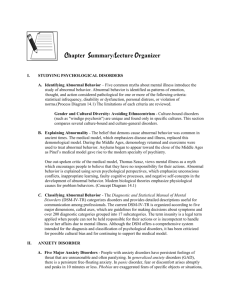Chapter 14: Psychological Disorders
advertisement

Chapter 14: Psychological Disorders Expanded Learning Outcomes Upon completion of Chapter 14, the student should be able to: Textbook Core LO: How do psychologists identify, explain, and classify abnormal behavior? 1. Describe five common myths regarding mental health and illness (p.496). 2. Define abnormal behavior, and describe and evaluate the four basic standards for identifying such behavior (pp. 497-499). 3. Differentiate between culture-general and culture-bound symptoms. State at least five culture-general symptoms (pp. 498; 499-500). 4. Summarize the historical progression in the definition of abnormality, and describe Szasz’s criticism of the medical model of mental illness (pp. 500-502). 5. Describe the development of the Diagnostic and Statistical Manual (DSM), including the DSM-IV-TR’s classification system, purpose, and limitations. Differentiate between neurosis, psychosis, and insanity (pp. 499; 503-506). Textbook Core LO: What are anxiety disorders, and what causes them? 6. Describe four major anxiety disorders and their possible causes (pp. 506-509). 7. Identify three factors believed to contribute to the manifestation of anxiety disorders (pp. 509-511). Textbook Core LO: When do disturbances in mood become abnormal? 8. Describe two major mood disorders and their possible biological and psychosocial causes (pp. 511-513). 9. Describe similarities and differences in depression across cultures and between genders (p. 513). 10. Utilize biological and psychological factors to form hypotheses about anxiety disorders (pp. 513-514). 11. Discuss ten common myths regarding suicide, list warning signs for teen suicide, and describe what steps to take if someone you know is suicidal (p. 515). Textbook Core LO: What are the symptoms and explanations for schizophrenia? 12. Define schizophrenia, and describe its five characteristic areas of disturbance; differentiate between positive and negative symptoms (pp. 517-520). 13. Discuss biological and psychosocial theories that attempt to explain schizophrenia (pp. 520-523). 14. Describe similarities and differences in symptoms of schizophrenia across cultures (p. 524). Textbook Core LO: How are substance-related, dissociative disorders and personality disorders identified? 15. Identify when substance use becomes substance abuse or dependence (pp. 525-525). 16. Define comorbidity and describe why alcohol use disorders often overlap with other mental disorders (pp. 525-526). 17. Identify the common characteristic for all dissociative disorders, and differentiate between dissociative amnesia, fugue, depersonalization, and identity disorder (pp. 526-527). 18. Describe the essential characteristics for all personality disorders, the four hallmark symptoms for an antisocial personality disorder, and the core features of borderline personality disorder; discuss the possible causes of these personality disorders (pp. 528-529).











